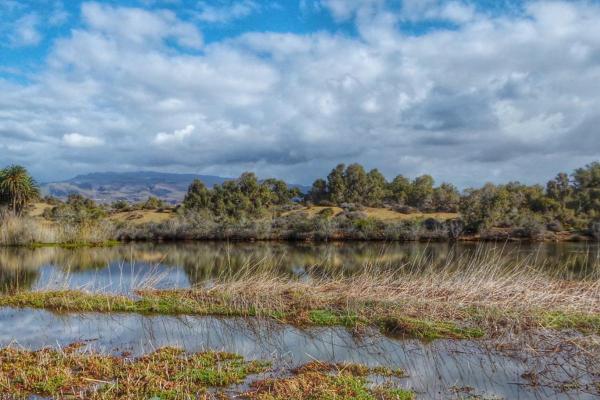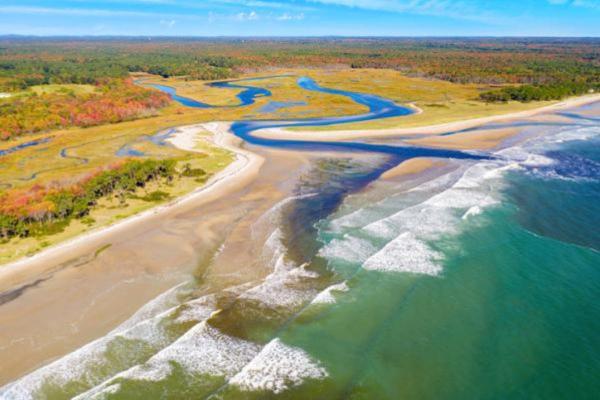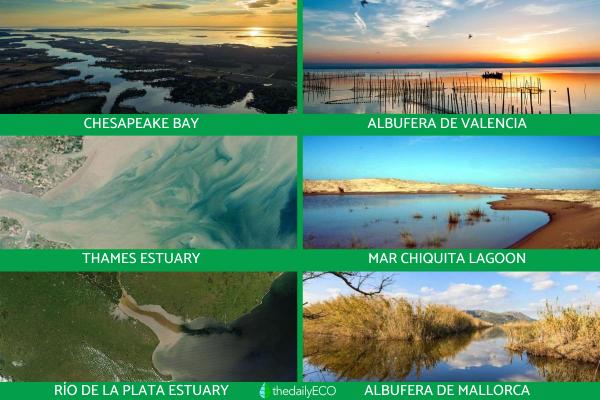
We should know that water gives life to our planet, but not all water is the same. Although 71% of the Earth's surface is covered by water, the vast majority is saltwater found mainly in seas and oceans. This saline water represents 97.5% of all water on Earth. While we may think the rest is freshwater, we are not taking into consideration another type known as brackish water. Found mainly in transition zones between bodies of fresh and salt water, the particular characteristics of brackish water has resulted in equally particular ecosystems in and around it.
At thedailyECO, we discover more about this type of water by asking what is brackish water? We look at a definition of brackish waters and discover their characteristics, as well as the ecosystems which form around it.
Brackish water definition
We have already explained that most of the world is covered in salt water from the oceans, but not all of the remaining water is considered fresh. The basic definition of brackish water is naturally occurring water which has a lower salinity than saltwater, but a higher salinity than freshwater. This is a general definition, so we can look at the specific characteristics of brackish water to have a better idea of what it is:
- Geographical location: it is necessary for brackish water bodies to have an inflow of fresh water or salt water, depending on their geographical location.
- Salinity: brackish water contains between 0.05% and 3% salt, below or above these values it is considered fresh or salt water, respectively.
- Conductivity: the salinity of water can be measured by conductivity as the higher the content of dissolved salts in the water, the higher the electrical conductivity.
- Water content: there may be the presence of different compounds in brackish water, such sodium, potassium, calcium, magnesium, chloride, sulfate, bicarbonate, carbonate and nitrate.
- Topographical location: brackish water can be found in different areas of land, specifically on the surface, near seas or saline rocks, but also underground in aquifers.
- Industrial use: brackish water can be used in the thermoelectric power industry to cool generators, to irrigate certain crop fields and to farm some species of fish.
- Freshwater conversion: brackish water can be industrially desalinated. The process is carried out by reverse osmosis to use it as drinking water, which could be a useful tool in combating water scarcity.
Now we have understood some of the main characteristics of brackish water, we can both how it is formed, as well as examples of brackish water in nature. Learn more about brackish water ecosystems and other ecosystems with our article on the difference between biotypes and biocenosis.

Types of brackish water habitats
As detailed above, brackish water can be found in different geographical and topographical locations. The type of area in which is is found greatly influences the flora and fauna associated with brackish water. For this reason, it should be helpful to look at the different types of brackish water habitats and how they are formed:
Lagoons
There are coastal lagoons that have been formed by seawater, but which are separated from the ocean itself. This is thanks to the inflow of freshwater which can come from bodies of freshwater or even precipitation. The result is a body of brackish water due to its level of salinity.
Lagoons are usually formed in areas where the tide is not very strong. This gives more time and opportunity for sediment to build and constructed a small barrier of separation to form the lagoon. Learn more with our article which details the differences between lakes and lagoons.
Estuaries
Estuaries are bodies of water are formed when the fresh water of a river meets the sea. The result is a mixture of fresh and salt water that becomes brackish. They are partially closed coastal bodies since one part is surrounded by the coast and the other is open to the sea.
These ecosystems are sometimes called lagoons, ports, bays or channels, but this can be misleading as they do not always conform to the definition of an estuary. This is due to the differences in the dynamics of water flow, even if they are similar overall. What they all do have in common is their content of brackish water. Estuaries are one of the most productive ecosystems in the world, thanks to the retention of nutrients in these areas.
Learn about estuaries and other bodies of water with our guide to different aquatic ecosystems.
Brackish water aquifers
There are two types of brackish water aquifers, there are those that are formed by:
- Being in contact with sea water: they are found near the coasts, where the groundwater under the sea is salty. They can also be located near inland waters where the water is fresh and they are constantly mixing. An interface zone is formed by brackish water that rises towards the sea which is why fresh water is constantly being lost, preventing the entry of seawater.
- Not being in contact with sea water: they are brackish aquifers that are formed by the effect of mineral rocks. The erosion of these rocks cause various salts to become part of the water solution, accumulating in aquifers with a certain degree of salinity.

Examples of brackish water
While brackish water bodies are the minority in terms of land surface covered, there are some well-known examples to be found across the globe. Below are some of the most ecologically important examples of brackish water in nature:
- Chesapeake Bay: the largest estuary in the United States located in the east of the country in contact with the Atlantic Ocean. More than 150 rivers flow into the bay and it covers an area of 64299 m2 (166,534 km2).
- Albufera de Valencia: a coastal lagoon located on the Balearic Sea that was declared a Natural Park. It is of great environmental importance, as there are endangered species such as the Spanish toothcarp (Aphanius iberus) and the Valencia toothcarp (Valencia hispanica).
- Thames Estuary: where the River Thames empties into the North Sea on the east coast of Great Britain. It constitutes an important access to marine traffic in the area. This estuary has the second largest tidal movement in the world as the water can rise up to 4 meters.
- Mar Chiquita Lagoon: located in Argentina, it is a lagoon separated from the sea by dunes. It was declared a Biosphere Reserve by Unesco. The salinity of this lagoon is due to the fact it receives water from the Argentine sea, as well as from continental freshwater streams.
- Río de la Plata estuary: located in Argentina and Uruguay, it is formed by the convergence of the Paraná and Uruguay rivers which flows into the Atlantic Ocean, forming a considerable estuary.
- Albufera de Mallorca: it is a lagoon located on the Island of Mallorca, which is separated from the Mediterranean Sea by a cordon of dunes. It has been declared a Natural Park with an area of 7.8 m2 (20.36 km2).
The type of water in a given location greatly influences the plant and animal species found within. Take a look at how brackish water affects certain types of marshes in this regard.

If you want to read similar articles to What Is Brackish Water? - Definition, we recommend you visit our Environment (other) category.
- United States Environmental Protection Agency. (n.d.). Basic Information About Estuaries. Retrieved from: https://www.epa.gov/nep/basic-information-about-estuaries
- Elbibliote. (n.d.). Brackish continental aquatic environments. Retrieved from: http://elbibliote.com/libro-pedia/manual_csnaturales/6grado/capitulo6/tema04.php?g=6&c=6&t=4
- Fluence. (2020). Brackish Water as a Resource. Retrieved from: https://www.fluencecorp.com/what-is-brackish-water/
- Grundfos. (n.d.). Mexico. Retrieved from: https://www.grundfos.com/mx/learn/research-and-insights/brackish-water
- Sanchez San Roman, F. J. (n.d.). Groundwater in coastal regions. University of Salamanca. Retrieved from: https://hidrologia.usal.es/temas/Regiones_costeras.pdf